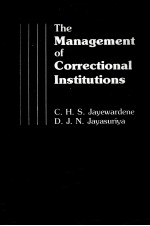图书介绍
The management of correctional institutionspdf电子书版本下载

- C.H.S. Jayewardene and D.J.N. Jayasuriya. 著
- 出版社:
- ISBN:0409840513
- 出版时间:1981
- 标注页数:190页
- 文件大小:8MB
- 文件页数:202页
- 主题词:
PDF下载
下载说明
The management of correctional institutionsPDF格式电子书版下载
下载的文件为RAR压缩包。需要使用解压软件进行解压得到PDF格式图书。建议使用BT下载工具Free Download Manager进行下载,简称FDM(免费,没有广告,支持多平台)。本站资源全部打包为BT种子。所以需要使用专业的BT下载软件进行下载。如 BitComet qBittorrent uTorrent等BT下载工具。迅雷目前由于本站不是热门资源。不推荐使用!后期资源热门了。安装了迅雷也可以迅雷进行下载!
(文件页数 要大于 标注页数,上中下等多册电子书除外)
注意:本站所有压缩包均有解压码: 点击下载压缩包解压工具
图书目录
Ⅰ. Managerial Perspectives 1
1.1 Traditional Autocracy 1
1.2 Management by Objective 3
1.3 Organization Development 5
1.4 Participatory Management 8
1.5 Rationale for Models of Management 10
1.6 The Development of Managerial Models 11
1.7 Contingency Model of Management 13
1.8 Aspects of Managerial Concern 14
1.9 Conclusions 16
Ⅱ. Defining Institutional Objectives 21
2.1 The Aims of Imprisonment 21
2.2 The Need for Defining Objectives 22
2.3 Custody and Treatment as Objectives 24
2.4 Prison as a Labour Organization 26
2.5 The Formulation of Objectives 28
2.6 Input of Interest Groups 29
2.7 The Role of Constraints 30
2.8 Objectives of a Penal Institution 30
2.9 Conclusions 32
Ⅲ. Strategic Planning and Programming 37
3.1 The Joinder of Means and Ends 37
3.2 Identifying the Base: The Extant Program of Work 39
3.3 The Activity - Objective Linkage 41
3.4 Assessment of Limitations 44
3.5 Level of Achievement 45
3.6 Translating Abstract Goals into Concrete Activity 47
3.7 Conclusions 48
Ⅳ. Managerial Aspects of Management 53
4.1 Parameters of Managerial Activity 53
4.2 Managerial Strategies 54
4.3 Worker Participation 56
4.4 Delegation of Authority 57
4.5 Decision-Making and Information 60
4.6 The Problems with Communication 61
4.7 Information Control 63
4.8 Conclusions 65
Ⅴ. The Managerial Concerns with Employees 71
5.1 Maximizing Production 71
5.2 The Needs of the Worker 73
5.3 Dimensions of Work 74
5.4 Group Endeavours 75
5.5 The Prison Setting 77
5.6 Staff Training and Development 78
5.7 The Work Schedule 80
5.8 Work Conditions and Fringe Benefits 82
5.9 Unionism 84
5.10 Conclusions 86
Ⅵ. Being Part of the Bureaucracy 91
6.1 Entrepreneurial Ability 91
6.2 Bureaucratic Surveillance 92
6.3 Bureaucratic Input 93
6.4 Separation of Powers 94
6.5 The Bureaucrat 96
6.6 Managerial Inaction 98
6.7 Decentralization 100
6.8 Managerial Cooperation 100
6.9 Conclusions 102
Ⅶ. Financial Restraints on Activity 107
7.1 The Role of Money 107
7.2 The Concept of Budgeting 110
7.3 Budget Execution 112
7.4 Budget Building 114
7.5 Performance and Program Budgeting 116
7.6 Zero Base Budgeting 118
7.7 Factorial Budgeting 120
7.8 Level of Institutional Efficiency 121
7.9 Conclusions 123
Ⅷ. Involving the Community 127
8.1 The Public and Public Policy 127
8.2 Public Policy and Public Desire 129
8.3 The Public: Active and Passive 130
8.4 Public Education 132
8.5 Community Advisory Committees 134
8.6 Voluntary Services 139
8.7 Public Facilities 141
8.8 Conclusions 141
Ⅸ. The Inmate 147
9.1 Inmate Orientation 147
9.2 Inmate-Staff Interaction 149
9.3 Prison Disturbances 151
9.4 The Prison Atmosphere 153
9.5 Adjustment to Prison Conditions 156
9.6 Prisoner Grievances 159
9.7 Prisoner Rights 161
9.8 Conclusions 162
Bibliography 169
Index 187